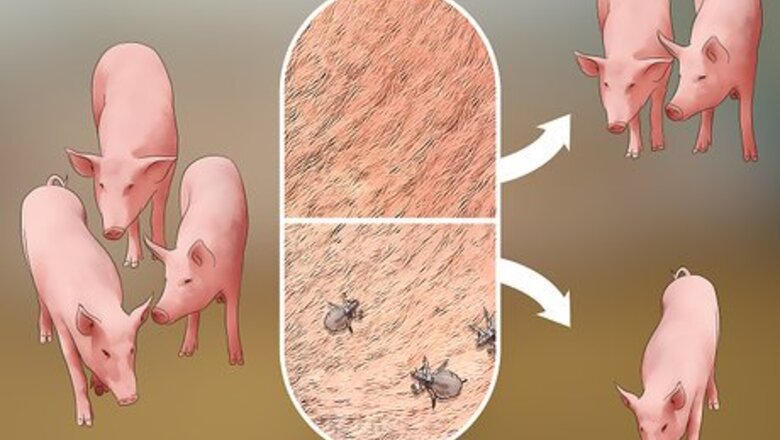
views
Taking Preventative Measures

Cull and repopulate your herd with pest-free livestock. Chronically infected pigs should be culled from the rest of your pig population. This is the best way to keep the bulk of your livestock healthy and free of pests or disease. However, it's important that you use only healthy pigs that are free of pests to restock your pig population so that you do not usher in a new wave of pest infestation. Restock your pig population with pest-free stock. Closely inspect all incoming pigs and keep all new, incoming pigs in quarantine.
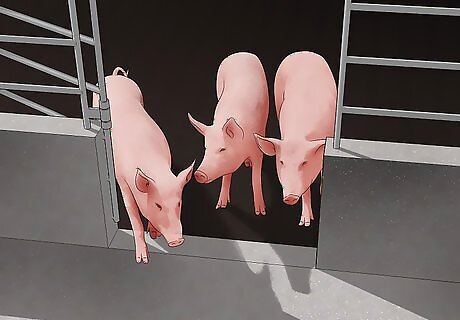
Quarantine any new incoming pigs. New livestock should always be viewed as potentially infected. You should choose new pigs from a trusted livestock source that you believe is free of pests, but remember that it's impossible to guarantee that a pig has never been exposed to lice or mites. New livestock should be quarantined away from the main herd for up to three weeks. Treat new, incoming pigs with an approved insecticide twice, with treatments spaced out two weeks apart. Then keep the pigs in isolation for an additional week to ensure they are free of parasites. Look for signs of lice and mange, including skin irritation, redness, scabs, and visible insects.

Wash yourself and your clothing. While pig lice and mites don't affect humans, you can act as a medium to transfer lice and mites to other pigs. To prevent this, it's imperative that you wash your hands/arms any time you handle an infected pig. You should also change your clothing and wash those garments before wearing them around any healthy pigs. Handle healthy pigs first, then work your way towards the infected pigs. This can help streamline the process of treating your pigs. Wash any exposed clothing in clean, hot water with soap. You may also want to consider spraying some insecticide on your clothing before washing them to ensure that all pests have been killed.
Using Insecticides On Your Pigs
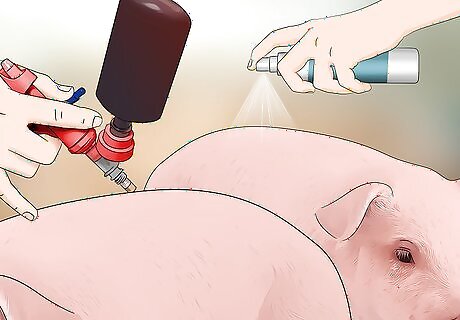
Apply an approved insecticide. There are a number of pesticides that can safely be used on infected pigs. It's important that you follow the directions on a given pesticide's label, as the application method may be specific for that particular insecticide. Spray pesticide only in well-ventilated open areas. Ask your veterinarian if you're unsure about whether a particular insecticide is safe to use or if you have any questions about how to safely administer an insecticide. Ivermectin (Ivomec) can be injected subcutaneously. It should be administered at least 18 days before slaughter. Amitraz (Point-Guard) can be poured on topically. It should be applied at least seven days before slaughter. Amitraz (Tactic) can be used topically as a spray or a dip. It should be applied at least one day before slaughter. Permethrin (Gard-Star 40EC) can also be applied as either a spray or a dip. It should be applied at least five days before slaughter. Fenvalerate (Ectrin WDL) can be applied as a spray only. It should be applied at least one day before slaughter. Ivermectin (Ivomec Swine Premix) should be administered orally through the pig's feed at least five days before slaughter. This insecticide is only recommended for pigs that weigh 220 pounds (99.8 kilograms) or less.

Disinfect swine living spaces between herds. In addition to disinfecting pigs, you should also disinfect their living spaces. Pests like lice and mites are transmitted through both direct contact and shared bedding and living spaces, so by treating an infected pig's living space you can help protect the pigs that will occupy that space in the future. Air out the barn and try to let as much sunlight in as possible. Pens that housed infected pigs should be cleaned and sprayed with an approved insecticide. Lice and mites cannot live for very long without host animals. Pens should be left unoccupied for at least three days after treating the living space, but keeping the barn free of livestock for up to two weeks is preferable. Any bedding used by infected livestock should be sprayed with insecticide or discarded entirely.

Treat the entire herd. If some of your pigs have contracted lice or mites, it's only a matter of time before those parasites spread to the rest of your livestock. Lice and mites typically spread through direct contact or shared bedding and living spaces, but they can also be transmitted through shared outdoor pasture space. Treat sows 30 to 45 days before farrowing and treat boars before breeding season. Treat piglets after weaning, around three weeks. If it is not possible to treat the entire herd at the same time, keep the treated pigs isolated from the untreated pigs. They should be kept in separate spaces and should not share a fenceline.
Trying Organic Treatment Methods

Feed your pigs a healthy diet. Though a pig's diet won't necessarily stop a pest infestation, good nutrition does help keep livestock healthy. Well-fed, well-cared for pigs tend to have a stronger resistance to infestations than unhealthy livestock. You can give your pigs access to pasture grazing, but they should also have high-fiber grain available. Any cereal grains you feed your pigs should be processed, meaning the grains are cracked, rolled, or soaked. This helps the grain become more easily digestible for pigs. Make sure your pigs have access to clean drinking water at all times.

Deliver piglets via caesarean birth. By delivering piglets that are free of parasites and keeping them quarantined from infected pigs, you can help ensure a healthy generation of pigs on your farm. Some experts suggest that caesarean-derived piglets are more likely to be free of mites than piglets delivered through a natural birth. Talk to a veterinarian about caesarean births for your pigs. Make sure newborn piglets are not exposed to infected livestock, as experts generally advise against using insecticides on piglets.
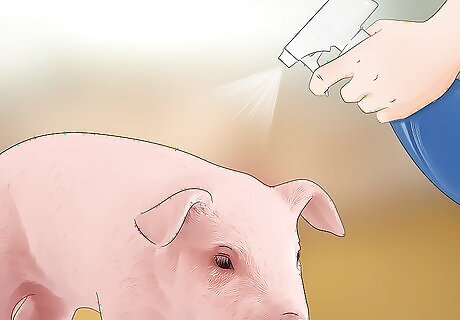
Use enzymatic soap. Enzymatic soap weakens the exoskeletons of insects and dehydrates them. This method is safe and nontoxic, but it is very labor intensive and may not be feasible for large herds or particularly bad infestations. You can buy enzymatic soap at many home supply stores or through online retailers, or make your own at home. Enzymatic soaps must typically be reapplied every seven days, as soap will not kill the eggs laid by previous populations of lice.
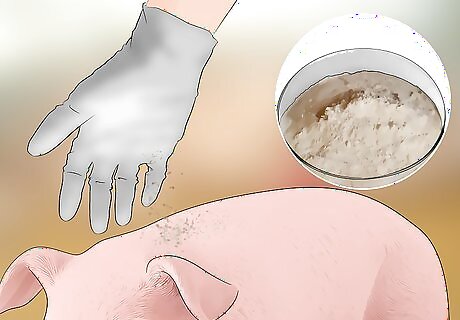
Apply pyrethrum powder. Pyrethrum powder is a naturally-derived chemical that has very low toxicity in mammals. It is applied as a dust directly on the pig's skin, but it can also be mixed with diatomaceous earth and hung in dust bags in your barn. You can buy pyrethrum powder at many home supply stores or through an online retailer. Reapply pyrethrum every seven days, as the powder will not kill eggs laid by previous lice populations. Always wear a mask while using pyrethrum. If at all possible, apply the powder to pigs outdoors or in a well-ventilated area.
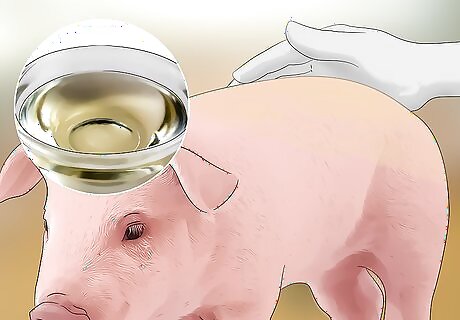
Try natural oils. While not as effective as other treatment methods, many people find that applying natural oils to an infected pig's skin can help control the pests. Oils suffocate existing lice and may affect a louse's ability to reproduce. Oils may also repel new pests from attaching to a host pig. Essential oils like anise, camphor, eucalyptus, pennyroyal, rosemary, and sassafras can all be safely applied to pigs. Mineral oil and vegetable oils can be applied to the skin to safely suffocate lice and mites.

















Comments
0 comment